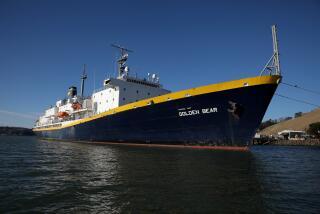Charles R. Larson, admiral who twice ran Naval Academy, dies at 77
- Share via
Retired Adm. Charles R. Larson, the onetime commander in chief of military forces in the Pacific who became superintendent of the U.S. Naval Academy to restore discipline and morale after his alma mater had been rocked by the largest cheating scandal in its history, has died. He was 77.
Larson’s death Saturday at his home in Annapolis, Md., was confirmed by his son-in-law, Cmdr. Wesley Huey, a faculty member at the academy. Huey said the four-star admiral had been diagnosed with leukemia two years ago.
Born Nov. 20, 1936, in Sioux Falls, S.D., Larson arrived at Annapolis in the 1950s, the first step in a naval career that would eventually span 40 years and take him across most of the globe. After his graduation in 1958 from the academy, where he was a classmate of John McCain, now a U.S. senator from Arizona, Larson became both an aviator and a nuclear submariner, twin achievements considered rare for a Navy man.
He served as a junior officer on two ballistic missile submarines and three attack submarines. According to a 2002 article in the Baltimore Sun, two of his seven Distinguished Service Medals were for his command of the USS Halibut, a submarine that retrieved sensitive equipment from Soviet vessels and tapped into Russian communication cables on the floor of the Pacific Ocean.
Larson was the first naval officer selected as a White House Fellow, and he served as naval aide to President Nixon.
In 1979, at age 43, he became the second-youngest admiral in U.S. history.
Larson first served as superintendent of the Naval Academy in the mid-1980s. A decade later, after having had one of the largest responsibilities in the military as commander in chief of the U.S. Pacific Command, Larson returned to Annapolis for an unusual second stint as superintendent. At the time, the academy was reeling from scandal. Twenty-four midshipmen had been expelled and 88 had been disciplined for sharing and lying about a stolen copy of an electrical engineering exam.
“My goals are very, very simple,” Larson told a gathering of academy officials, alumni and midshipmen in 1994. “No. 1: to develop character. No. 2: to prove the worth of the service academies to the people of the United States.”
By many accounts, Larson accomplished that mission. He was widely credited with shaping the academy into a more disciplined institution and with establishing a curriculum that focused on character development.
“The most important thing he did for the Naval Academy was to bring it back from a deep malaise,” McCain, Larson’s Annapolis classmate and flight school roommate, told the Baltimore Sun in 2002.
After retiring from the Navy, Larson worked in the private sector, serving on boards of companies in the defense, aerospace, energy and construction industries. He also served as vice chairman of the University System of Maryland Board of Regents and chaired a blue-ribbon task force on reforms to university governance and funding.
In 2002, Larson, who had no political experience, ran unsuccessfully for lieutenant governor, switching his party affiliation from Republican to Democrat to be the running mate of Kathleen Kennedy Townsend, daughter of Robert F. Kennedy.
Larson is survived by his wife of 52 years, Sally, three daughters and seven grandchildren.
Rodricks writes for the Baltimore Sun, a Tribune newspaper.
More to Read
Start your day right
Sign up for Essential California for the L.A. Times biggest news, features and recommendations in your inbox six days a week.
You may occasionally receive promotional content from the Los Angeles Times.






